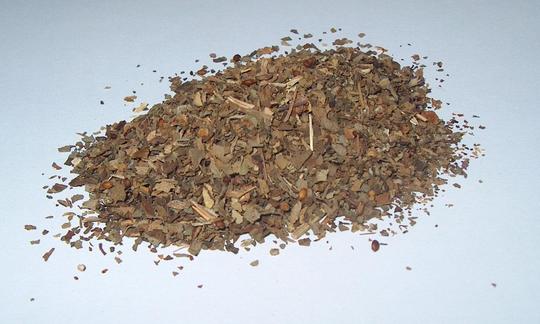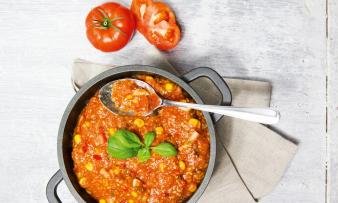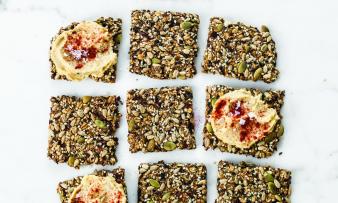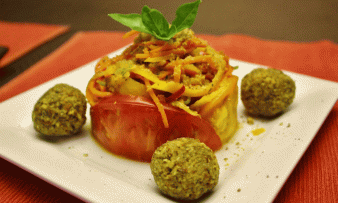Table of contents
Dried basil ( Ocimum basilicum) is a practical and long-lasting alternative to fresh basil ( raw). Dried (or freeze-dried) and shredded organic basil is readily available in stores, including in raw food quality (raw quality).
Dried basil: Use in the kitchen
Dried basil leaves are less aromatic than fresh ones. Nevertheless, the spice, with its slightly sweet to peppery taste, is a popular seasoning in Mediterranean and plant-based (vegan or vegetarian) cuisine. Since a large part of the aroma is lost during heating or cooking, dried basil spice should be added at the end of the cooking time or after cooking. Suitable herb combinations are created with sage, garlic, rosemary, oregano or thyme.
Basil use: Dried basil can be used to season raw or cooked dishes, e.g. salads, sauces, marinades, pizzas, pasta, vegetables or raw food (e.g. tomatoes), herb pestos, soups or dips. Dried basil is suitable for pickling in oil or vinegar (e.g. mild wine vinegar).
Alternative names such as 'German pepper' or 'soup basil' indicate the aroma and certain uses in the kitchen.
Vegan recipe for tomato pesto with basil (dried):
Ingredients (for four people): 100 g dried tomatoes, cut into pieces; 40-80 ml rapeseed oil ( walnut oil or hemp oil) as needed; 75 g raw walnuts, roughly chopped; 20 g basil, dried (organic); 2 raw garlic cloves, peeled and quartered; salt andpepper.
Preparation: Soak the dried tomato pieces in lukewarm water for about 30 minutes and then pass them through a sieve. Now puree all the ingredients with a powerful hand blender in a tall, narrow cup and season the pesto with salt and pepper. If you want to keep the vegan pesto in the fridge, put the mixture in a screw-top jar, smooth it out and add a final, thin layer of oil.
Vegan recipes with dried basil can be found under the note: " Recipes that have the most of this ingredient ".
| Not only vegans or vegetarians should read this: Vegans often eat unhealthily. Avoidable nutritional mistakes. |
Shopping - where to buy basil (dried)?
Dried basil spice can be bought shredded, freeze-dried or powdered at popular supermarket chains such as Coop, Migros, Denner, Volg, Spar, Aldi, Lidl, Rewe, Edeka or Hofer as well as in organic supermarkets such as Denn's Biomarkt or Alnatura. Good addresses for controlled organic quality (organic) are organic shops and health food stores. Dried basil spice is also available in raw food quality (raw quality), gently dried at a maximum of 40 °C.
Found in the wild:
Basil (Royal Basil) is an annual, herbaceous and bushy plant, growing to around 50 cm in height. The egg-shaped, entire or slightly toothed leaves have long stalks. The flowers of the axillary umbels are white, pink or purple. Royal Basil is found in gardens and cultivated areas north of the Alps. Wild plants are rarely found there. 1
Preparing your own basil (dried):
If you want to dry raw basil yourself, you should not exceed temperatures of 35 °C. This will prevent the leaves from turning brown and the flavor from losing too much. At the same time, this gentle drying process produces a product of raw food quality. Avoid washing the basil leaves beforehand. If necessary, you can rinse them briefly under cold water and dry them with kitchen paper.
Suitable drying methods include drying in the air, in the oven or in a dehydrator. When air drying, good circulation of the ambient air is important; direct sunlight should be avoided. If you want to achieve a faster result (after about 1-2 hours), drying in the oven at the lowest temperature is suitable. It is important to keep the oven door slightly open so that the moisture can escape easily. Even lower temperatures can be set on the dehydrator, but the drying time increases significantly (up to 24 hours). With all methods, it is important to distribute the picked leaves evenly and loosely.
Air drying in bunches is less suitable for basil leaves because of the high water content of the plant. This method can lead to the formation of mold.
You can tell when basil leaves are sufficiently dried by their dull rustling sound. You can then rub them together with clean hands.
Storage of dried basil leaves:
Dried basil spice should be stored in glass or metal containers, protected from light and moisture. Storing dried basil in plastic containers is not a good idea, as they have a negative effect on the essential oil. 2
Basil ingredients - calories - nutritional values:
Here we realistically show you the ingredients of spices and herbs per 1 g (instead of per 100 g as usual).
1 g of dried basil spice contains 0.04 g of fat, 0.48 g of carbohydrates and 0.23 g of protein. The calorie content is 2.33 kcal. 3.4
Does dried basil contain vitamin K? 1 g of dried basil is rich in vitamin K with 17.1 µg and can cover almost a quarter of the daily requirement of the fat-soluble vitamin. The same amount of basil (dried) provides 0.9 mg of iron and 0.1 mg of manganese. 3,4
More vitamin K can be found in dried wild garlic (26.3 µg/1g) than in dried basil leaves; lower amounts can be found in dried parsley (13.6 µg/1g). Comparable amounts of iron can be found in moringa powder (0.98 mg/1g) - and manganese in dried parsley (0.1 mg/1g). 3,4
In fresh basil leaves (raw), the essential oil content varies between 0.04 and 0.7%, depending on the origin and time of harvest. According to the German Drug Codex ( DAC), basil used medicinally must contain at least 0.4% essential oil. The main components are linalool, methyl chavicol (estragole) and methyl cinnamate. 2 Depending on the drying method, dried basil leaves also contain notable amounts of essential oil 12,14,15 and secondary plant substances. 16
You can find out exactly which other ingredients the fresh spice contains (basil nutrients, basil nutritional values) under the title of the same name in the ingredient Basil, fresh (organic?).
The complete ingredients (e.g. vitamins) of dried basil, the coverage of the daily requirement and comparison values with other ingredients can be found in our nutrient tables in CLICK FOR below the ingredients picture.
Health aspects - effects:
Is dried basil spice healthy? According to Wichtl -Teedrogen und Phytopharmaka (2016), no (sufficiently) confirmed effects have been proven for the royal herb. 2
Recent studies indicate antioxidant, antibacterial, antifungal and anticarcinogenic effects. Laboratory techniques have been able to demonstrate some of these effects on pathogens and (human) cancer cell lines. Essential oils from basil could be promising for the food, medicine and cosmetics industries. There are a few clinical studies available. 5,6,7 Scientific reviews confirm the strong antioxidant capacities of O. tenuiflorum, or Indian basil (see below under "Possibility of confusion"). 6
Dangers - Intolerances - Side effects:
Estragole proved to be mutagenic (liver tumors) in animal studies. The animals were given the pure substance for twelve months. The results are to be regarded as indications and cannot be transferred to dried or fresh basil herb. 2
Is basil healthy or unhealthy? The Federal Institute for Risk Assessment ( BfR) expressly points out that it is not necessary to avoid basil. Occasional use in the kitchen is acceptable as long as it is not used on a permanent basis. Estragole and methyleugenol are found in other plants such as tarragon, star anise, allspice, nutmeg, lemongrass and fennel. 8,9 We believe that describing basil as unhealthy is a disproportionate statement.
Is basil carcinogenic? A recent review (scientific review) from 2018 concludes that basil is safe for consumption in food from a toxicological point of view. The plant's own flavonoid nevadensin counteracts the carcinogenic potential. However, for essential oils, it is appropriate to set a maximum level for estragole and methyl chavicol. 5
In principle, the estragole problem would be more serious if the estragole type was available on the market rather than the linalool type described in the DAC. Although the estragole type does not pose an acute health risk, medicinal use should be avoided for safety reasons. 2
Use as a medicinal plant:
HMPC ( Committee on Herbal Medicinal Products) and ESCOP ( European Federation of National Societies for Phytotherapy) have not yet examined basil. Commission E wrote a negative monograph because of insufficiently documented effects and possible risks. 2
Folk medicine - natural medicine:
Is basil used in medicine? In Mediterranean countries, basil (Krampfkräutl, Joseph's herb) is used in folk medicine: for loss of appetite (as a stomachic), for flatulence and a feeling of fullness (as a carminative), occasionally to increase urine production (as a diuretic), to promote milk production (as a lactagogue for lactation, incorrect spelling: lactaction) and externally as a gargle and astringent for inflammation of the throat. 2 In empirical medicine, fresh (raw) or dried basil is used for women's problems, migraines and rarely for diseases of the urinary organs. 1,10
Occurrence - Origin:
The home of basil (also known as king's herb, brown silt or basil) is not known for certain. It is believed that it originally came from India or tropical and subtropical Asia. The herb basil spread widely from there. Today, basil is cultivated in the subtropics, especially in the entire Mediterranean region, in various breeds and varieties. 1,2
Possibility of confusion:
We are not aware of any confusion between basil and poisonous plants. It is possible that the numerous types and varieties of basil cannot always be clearly identified. There is a possibility of confusion with Indian basil ( Ocimum tenuiflorum syn. Ocimum sanctum, Tulsi, Holy Basil) or Thai basil, whereby the first-mentioned Ocimum species is often also called Thai basil (at least the Holy Basil used in Thai cuisine = Kaprao).
Industrial production:
In industry, raw basil leaves are mostly dried using hot air in special ovens or on belts. Freeze-drying, on the other hand, uses liquid nitrogen to cause a shock cooling to -18 °C. The ice that is created can be converted into a gaseous state in a vacuum, thus removing the liquid from the herbs. This technique preserves the structure of the basil, its natural color and its flavor as best as possible. Sieves or blowers clean the herb of sand, earth or stones. Special mills mechanically shred the basil leaves. 11
Herbs are sometimes contaminated with germs that can be harmful to health or reduce their shelf life. These are therefore removed using special steam and heat disinfection processes. Treatment with ionizing radiation is permitted within the EU. This method is not used in every EU country and some countries only import non-irradiated goods. 11
A research team at the University of Hohenheim is currently investigating (project from 2020) whether the aroma profile of basil (dried) can be improved by a special short-term drying process than by freeze-drying. The first steps in this project are: washing, wet grinding and wet pasteurization for disinfection. This is followed by short-term drying within a few seconds in a spray dryer under oxygen exclusion. 12
In contrast to mass-produced goods, organically grown herbs from the region can be dried in smaller quantities. This means that the local supplier can rely on gentle drying with little heat and does not have to sterilize, or only needs to sterilize gently. 13
General information:
Basil ( Ocimum basilicum) is a spice plant from the genus Basil ( Ocimum) in the family Lamiaceae or Labiatae.
The various types of basil differ in size, leaf shape, leaf color and fragrance. Commonly grown varieties are 'Big Green', 'Genovese' and 'Opal' (red-leaved). Basil can be eaten fresh as a spice herb, including the variants of Thai basil.
Alternative names:
German alternative names for basil (dried or fresh) are: brown basil, German pepper, cramp basil, soup basil, basil herb, basil, basilicum, Joseph's herb and royal herb (the species epithet basilicum comes from the Greek word for royal); incorrect spelling (m.): fresh basil.
English names are dried Sweet Basil, dried Garden Basil or Basil, dried - in Turkish it is called reyhan otu kurusu or fesleğen kurusu, in Russian базилик сушеный.
What are the medical names of the basil drug? In Latin, the drug (= outdated for medicine) is called Basilici herba (syn. Herba Basilici, Herba Ocimi) and essential basil oil is called Basilici aetheroleum (syn. Oleum Basilici).
Literature - Sources:
Bibliography - 16 Sources
| 1. | Pahlow M. Das grosse Buch der Heilpflanzen. Gesund durch die Heilkräfte der Natur. Hamburg: Nikol Verlagsgesellschaft mbH & Co. KG; 8. Auflage. 2019. |
| 2. | Blaschek W. (Herausgeber). Wichtl –Teedrogen und Phytopharmaka. Ein Handbuch für die Praxis. Stuttgart: Wissenschaftliche Verlagsgesellschaft mbH; 6. Auflage. 2016. |
| 3. | Diet-health.info Nährstofftabellen. |
| 4. | USDA (United States Department of Agriculture). Nährstofftabellen. |
| 5. | Sestili P, Ismail T, Calcabrini C et al. The potential effects of Ocimum basilicum on health: a review of pharmacological and toxicological studies. Expert Opin Drug Metab Toxicol. 2018;14(7):679-692. |
| 6. | Avetisyan A, Markosian A, Petrosyan M et al. Chemical composition and some biological activities of the essential oils from basil Ocimum different cultivars. BMC Complement Altern Med. 2017;17(1):60. |
| 7. | Rezzoug M, Bakchiche B, Gherib A et al. Chemical composition and bioactivity of essential oils and ethanolic extracts of Ocimum basilicum L. and Thymus algeriensis Boiss. & Reut. from the algerian saharan atlas. BMC Complement Altern Med. 2019;19(1):146. |
| 8. | Ugb.de UGB-Stellungnahme. Überzogene Warnung vor Fencheltee. 2002. |
| 9. | Bfr.bund.de Estragol- und Methyleugenolgehalte in Lebensmitteln verringern. 2002. |
| 10. | Fleischhauer SG, Guthmann J, Spiegelberger R. Enzyklopädie. Essbare Wildpflanzen. 2000 Pflanzen Mitteleuropas. Aarau: AT Verlag; 1. Auflage. 2013. |
| 11. | Bzfe.de Vom Acker bis zum Teller. Kräuter: Verarbeitung. Von Kötter E, Walldürn-Rippberg. 2020. |
| 12. | Fei-bonn.de Mehr Aroma für getrocknete Kräuter und Gewürze: Forschungsgruppe entwickelt neue Prozessführung zur Haltbarmachung mit gleichzeitiger Qualitätsverbesserung. |
| 13. | Heuschrecke.com Trocknungsverfahren für Kräuter und Gewürze. Nicht alles geht als Rohkost - differenzierte Betrachtung. |
| 14. | Wiemer J. Ätherische Öle in Kräutern und Gewürzen. Wirkung auf den menschlichen Organismus und Lebensmittel. Hamburg: Diplomica Verlag. 2009. |
| 15. | Baritaux O, Richard H, Touche J et al. Effects of drying and storage of herbs and spices on the essential oil. Part I. Basil, Ocimum basilicum L. Flavour and Fragrance Journal. 1992; 7(5): 267–271. |
| 16. | Henning SM, Zhang Y, Seeram N P et al. Antioxidant capacity and phytochemical content of herbs and spices in dry, fresh and blended herb paste form. International Journal of Food Sciences and Nutrition. 2010; 62(3): 219–225. |











Comments